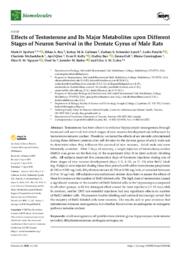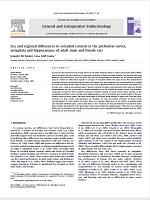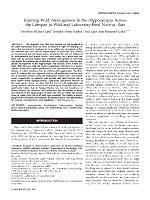Galea, Liisa A.M.
Person Preferred Name
Liisa A.M. Galea
Related Works
Content type
Digital Document
Abstract
Testosterone has been shown to enhance hippocampal neurogenesis through increased cell survival, but which stages of new neuron development are influenced by testosterone remains unclear. Therefore, we tested the effects of sex steroids administered during three different periods after cell division in the dentate gyrus of adult male rats to determine when they influence the survival of new neurons. Adult male rats were bilaterally castrated. After 7 days of recovery, a single injection of bromodeoxyuridine (BrdU) was given on the first day of the experiment (Day 0) to label actively dividing cells. All subjects received five consecutive days of hormone injections during one of three stages of new neuron development (days 1–5, 6–10, or 11–15) after BrdU labeling. Subjects were injected during these time periods with either testosterone propionate (0.250 or 0.500 mg/rat), dihydrotestosterone (0.250 or 0.500 mg/rat), or estradiol benzoate (1.0 or 10 µg/rat). All subjects were euthanized sixteen days later to assess the effects of these hormones on the number of BrdU-labeled cells. The high dose of testosterone caused a significant increase in the number of BrdU-labeled cells in the hippocampus compared to all other groups, with the strongest effect caused by later injections (11-15 days old). In contrast, neither DHT nor estradiol injections had any significant effects on number of BrdU-labeled cells. Fluorescent double-labeling and confocal microscopy reveal that the majority of BrdU-labeled cells were neurons. Our results add to past evidence that testosterone increases neurogenesis, but whether this involves an androgenic or estrogenic pathway remains unclear.
Origin Information
Content type
Digital Document
Abstract
In general, the behavioral and neural effects of estradiol administration to males and females differ. While much attention has been paid to the potential structural, cellular and sub-cellular mechanisms that may underlie such differences, as of yet there has been no examination of whether the differences observed may be related to differential uptake or storage of estradiol within the brain itself. We administered estradiol benzoate to gonadectomized male and female rats, and compared the concentration of estradiol in serum and brain tissue found in these rats to those of gonadectomized, oil-treated rats and intact rats of both sexes. Long-term gonadectomy (3 weeks) reduced estradiol concentration in the male and female hippocampus, but not in the male or female amygdala or in the female prefrontal cortex. Furthermore, exogenous treatment with estradiol increased estradiol content to levels above intact animals in the amygdala, prefrontal cortex and the male hippocampus. Levels of estradiol were undetectable in the prefrontal cortex of intact males, but were detectable in all other brain regions of intact rats. Here we demonstrate (1) that serum concentrations of estradiol are not necessarily reflective of brain tissue concentrations, (2) that within the brain, there are regional differences in the effects of gonadectomy and estradiol administration, and (3) that there is less evidence for local production of estradiol in males than females, particularly in the prefrontal cortex and perhaps the hippocampus. Thus there are regional differences in estradiol concentration in the prefrontal cortex, amygdala and hippocampus that are influenced by sex and hormone status.
Origin Information
Content type
Digital Document
Abstract
The dogmatic view that new neurons are not produced in the adult mammalian brain has been overturned in light of mounting evidence that neurogenesis continues to occur within two neurogenic niches, the subventricular zone and the hippocampus. In mammals, new neurons are incorporated into the hippocampus throughout life and are influenced by environmental and genetic factors. Most studies use captive-bred animals, and no previous studies have examined neurogenesis in free-living rats despite the common use of laboratory rats. In particular, exercise upregulates neurogenesis in the hippocampus and exercise levels would certainly differ between wild and captive populations. Therefore, it is unclear whether results from captive populations can be generalized to natural populations or reflect variations from an artificial and inappropriate "baseline" level. To address this, we compared levels of cell proliferation and the number of immature neurons (using the endogenous markers Ki67 and doublecortin, respectively) in captured wild juvenile and adult Norway rats to three captive strains (Sprague-Dawley, Long-Evans, and Brown Norway) of the same species. Here, we show that the level of cell proliferation and young immature neuron survival in the dentate gyrus of juvenile wild rats is significantly higher than in Sprague-Dawley rats, but not Long-Evans or Brown Norway rats. However, cell proliferation and the number of immature neurons in the hippocampus of adult wild rats are within the normal range of captive-bred rats at all adult ages examined. This finding is surprising given the dissimilar environments, including stressors and opportunities for exercise, encountered by each population. © 2009 Wiley-Liss, Inc.
Origin Information



